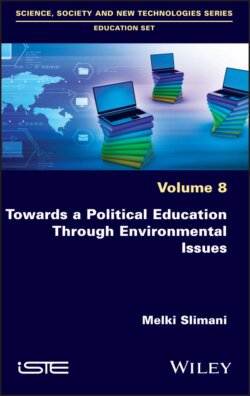Читать книгу Towards a Political Education Through Environmental Issues - Melki Slimani - Страница 2
Table of Contents
Оглавление1 Cover
2 Title Page
3 Copyright
4 Foreword: Laying Down the Principles of Intentional Political Curricula for the Anthropocene World
5 Introduction
6 1 The Political Trend in Environmental Issues 1.1. Politics, the political and depoliticization 1.2. The political and the anti-political 1.3. Environmental and development issues (EDIs) between the political and anti-political or politics and depoliticization: what are the trends? 1.4. Conclusion
7 2 The Political Potential of Environmental Issues 2.1. The regulatory categories of political life 2.2. The regulatory categories of political life in situations involving environmental and development issues 2.3. Conclusion
8 3 Political Learning and Socialization in Teaching Environmental Issues 3.1. Educational purposes and projects: sociological, pedagogical and didactic approaches 3.2. Evolution of the contributions of didactic research for the educational purposes of socialization 3.3. Teaching of environmental and development issues and political learning: integrating socialization purposes 3.4. Conclusion
9 4 Methodological Considerations 4.1. Case study methodology 4.2. Selection of case studies 4.3. Defining the analytical criteria 4.4. Procedure for data collection and analysis 4.5. Defining the research quality criteria
10 5 The Political within “Education for Sustainable Development Goals” 5.1. Analysis of the Sustainable Development Goals (SDGs) 2030 5.2. Analysis of the content of “Education for SDGs”
11 6 The Political within the Tunisian Curriculum 6.1. Secondary school curriculum analysis 6.2. Analysis of the undergraduate curriculum: the bachelor’s degree in environmental protection
12 Conclusion C.1. The “micro” level of the political/anti-political trend of EDIs C.2. The “meso” level of the political potential of EDIs C.3. The “macro” level of political learning in educational situations involving EDIs C.4. The political/anti-political trend and political potential of EDIs in the texts of the UN 2030 SDGs and the UNESCO “Education for SDGs 2030” C.5. The political/anti-political trend and political potential of EDIs between the prescribed curriculum, the potential curriculum and the produced secondary school curriculum C.6. The political/anti-political trend and political potential of EDIs between the 2009 prescribed university programs, the 2015 prescribed university programs and the produced curriculum for the environmental protection degree program C.7. The political potential and the potentialities for socialization in terms of political learning between the prescribed curriculum, the potential curriculum and the produced secondary school curriculum C.8. The political potential and the potentialities for socialization in terms of political learning between the 2009 university prescribed curricula, the 2015 prescribed curricula and the produced curriculum from the environmental protection degree
13 Appendices
14 Appendix 1: Interviews: Guides and Help Lists
15 Appendix 2: Report on Political Elements in the SDG 2030 Agenda and in the Contents of “Education for 2030 SDGs”
16 Appendix 3: Report on political elements in the Tunisian Curriculum
17 Glossary
18 References
19 Index
20 End User License Agreement
